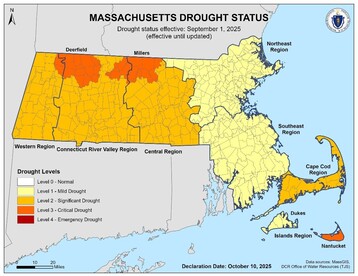Critical Drought Conditions Declared On Nantucket
Nantucket Current •

Drought conditions have worsened on Nantucket to Level 3-Critical Drought following an announcement from Energy and Environmental Affairs secretary Rebecca Tepper on Friday as drought conditions have continued to plague the northern half of Massachusetts.
“All regions in Massachusetts are currently experiencing varying levels of drought conditions,” said EEA Secretary Rebecca Tepper. “We can all do our part to avoid overstressing water systems by being careful about indoor water use. We appreciate everyone’s vigilance as we try to manage this persistent drought.”
The Massachusetts Drought Management Task Force had designated Nantucket in the Level 2 category for “significant” drought conditions in September after the island had been designated as being in Level 1 since June, which prompted the town toimplement water use restrictions and establish penalties for violators.
The Wannacomet Water Company has been monitoring water use by those on the municipal system since July. While it issued warnings, no property owners were fined for violating the water use restrictions.
Nantucket Water Department head Mark Willett said last month the Level 2 designation would likely mean water use restrictions would continue to tighten further on the island to prohibit all outside water use for those on the municipal system. Private wells are exempt from these restrictions.
Recommendations from the state on how to properly manage water levels include:
- Minimize overall water use.
- Ban on all nonessential outdoor water use.
- Follow state water conservation actions and any local water use restrictions.
- Monitor total household water use shown on your water bill for sudden increases, which often indicate leaks. Use the MA Home Water Use Calculator tool to evaluate household water use.
- Fix any toilet or faucet leaks immediately. Check for leaks in homes and businesses regularly by: Checking water meters for constant dial movement; Using dye tabs to check for toilet leaks; Conducting regular inspections of all pipes and fixtures, including those located in utility rooms, crawlspaces, and other hidden areas.
- Use dishwashers rather than handwashing dishes. Run the dishwasher only on a full load.
- Aggressively reduce indoor water use by: Reducing shower length and consider using a shower timer; Running washing machines only on a full load.
- Not letting water run while brushing and shaving.
- Replacing old fixtures and appliances with water-efficient ones. Make sure toilets, faucets, and showerheads are WaterSense labeled .
- Stop all non-essential water use.
- Be extra cautious with outdoor fires, grills, and flammable materials.